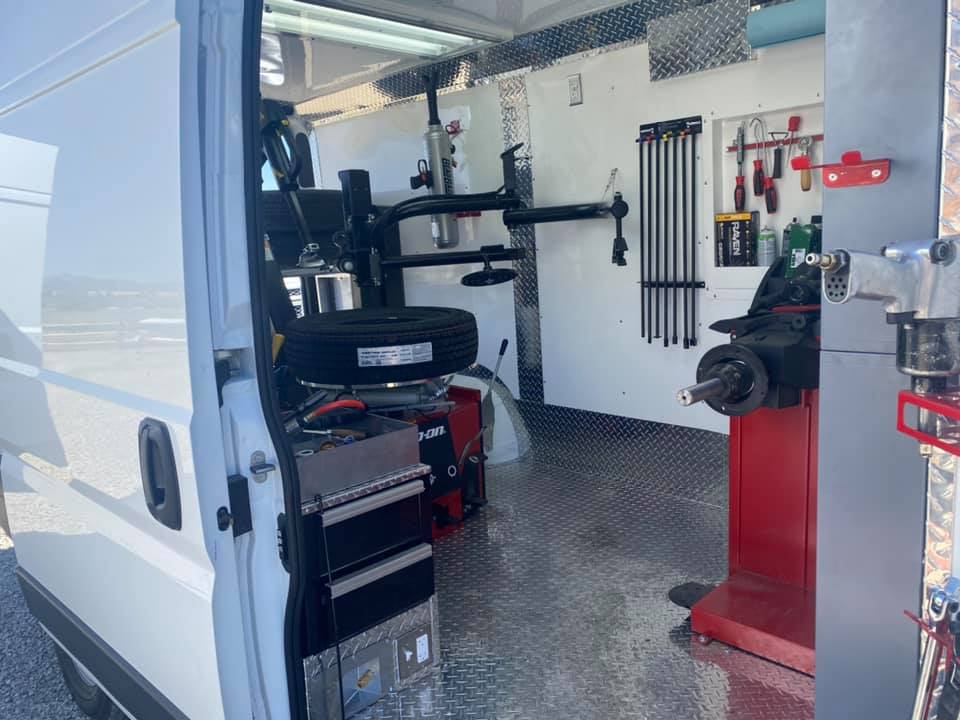Quick Response Mobile Tire Change Service in Las Vegas
Quick Response Mobile Tire Change Service in Las Vegas
Blog Article
Tire Service: Proven Methods for Ideal Tire Maintenance and Treatment
Maintaining ideal tire condition is paramount for both security and performance of any car. From ensuring correct tire stress to normal turning and positioning, there are tested techniques that can significantly extend the life-span of your tires and enhance total driving experience. As we check out the complexities of tire treatment and upkeep, we will reveal necessary standards that every automobile proprietor should abide by for the finest possible outcomes. Allow's explore the globe of tire service and find the keys to maintaining your tires in excellent shape for the long run.
Significance of Tire Stress
Proper tire stress is a critical consider ensuring ideal vehicle efficiency and security when driving. Preserving the recommended tire pressure degrees offered by the supplier uses many advantages. Ample tire pressure promotes much better gas performance, as under-inflated tires can lead to enhanced rolling resistance, causing the engine to function harder and consume more fuel. Proper tire stress ensures even walk wear, enhancing tire longevity and saving money in the lengthy run by delaying the need for premature substitutes. Additionally, properly blew up tires add to enhanced handling and braking abilities, critical for secure driving in various roadway problems. Over-inflated tires, on the other hand, can lead to reduced grip and a harsher trip. Conversely, under-inflated tires are prone to getting too hot, which can bring about blowouts and accidents. On a regular basis examining and readjusting tire stress, especially previously lengthy journeys, is a basic yet reliable way to boost automobile performance, expand tire lifespan, and prioritize safety and security when traveling.
Tire Turning Guidelines
When taking into consideration tire turning guidelines, it is vital to comprehend the significance of this maintenance task in making best use of tire life expectancy and keeping ideal vehicle performance. Tire rotation entails transforming the placement of each tire on a vehicle to make sure even tread wear. Front tires have a tendency to use more quickly than back tires because of steering pressures, making routine rotation crucial for well balanced wear patterns. The suggested turning pattern varies depending on whether a car is front-wheel, rear-wheel, all-wheel, or four-wheel drive. Usually, tires must be rotated every 5,000 to 7,500 miles, or as advised in the automobile guidebook. Disregarding tire turning can lead to irregular wear, influencing handling, grip, and potentially compromising automobile safety and security. By sticking to correct turning guidelines, chauffeurs can extend the life of their tires, boost gas performance, and enhance total driving experience. Regular rotation is an easy yet efficient upkeep method that contributes considerably to tire durability and car performance.

Advantages of Wheel Placement
Guaranteeing correct wheel alignment after tire rotation is crucial for keeping well balanced wear patterns and maximizing lorry performance. Wheel placement describes the modification of the angles of the wheels to the producer's requirements. One of the key advantages of wheel placement is enhanced guiding and handling response. When the wheels are correctly lined up, it minimizes steering initiative, guaranteeing a smoother and more regulated driving experience. Furthermore, correct wheel alignment helps to extend the life-span of your tires. Misaligned wheels can create unequal tire wear, leading to early tire replacement and increased maintenance prices.

Tire Footstep Depth Examine
Performing a routine examination of tire tread depth is vital for maintaining risk-free driving conditions and prolonging the life expectancy of your tires. The tread on your tires plays an essential duty in offering traction, particularly in unsafe or damp problems. To examine your tire walk deepness, you can make use of a step deepness scale or the penny test. The recommended tread depth is at least 2/32 of an inch. It is time to replace your tires to guarantee optimal performance and safety on the road if the step depth is below this threshold. Irregular tread wear can suggest concerns with tire alignment, pressure, or suspension, highlighting the importance of regular walk deepness checks. Disregarding to check and keep appropriate walk deepness can cause minimized hold, longer stopping distances, and an enhanced danger of hydroplaning. By integrating tire walk depth checks into your regular upkeep schedule, you can drive with self-confidence knowing that your tires are in leading condition.
Seasonal Tire Evaluation
A thorough analysis of tire problem tailored to particular weather is critical for keeping optimum performance and security throughout the year. Seasonal tire inspection is an essential facet of tire maintenance that makes certain tires are prepared to encounter the difficulties presented by different weather. To prepare for wintertime, it is important to inspect the tire stress frequently as cool temperatures can trigger tire stress to go down. Examining tire tread deepness is also essential to guarantee appropriate grip on snow and frozen roads. Additionally, looking for indicators of damage, such as cracks or bulges, click over here now can help protect against potential tire failings. As the periods adjustment, it is necessary to assess tire condition and make any required modifications to ensure risk-free driving. By performing routine seasonal tire inspections, motorists can lengthen tire life expectancy, enhance fuel performance, and most importantly, ensure a secure driving experience in varying weather - Mobile Tire Service Las Vegas.
Verdict
In final thought, preserving appropriate tire pressure, turning tires on a regular basis, lining up wheels correctly, checking walk deepness, and carrying out seasonal inspections are necessary practices for optimum tire care. By adhering to these shown approaches, chauffeurs can guarantee their tires last longer, carry out far better, and add to overall car safety and security. It is essential to focus on tire upkeep to stop accidents, boost gas efficiency, and prolong the life expectancy of tires.
Ample tire stress promotes far better fuel effectiveness, as under-inflated tires can lead to increased rolling resistance, triggering the engine to work harder and consume even more fuel.When considering tire rotation guidelines, it is important to comprehend the value of this maintenance task in making the most of tire life-span and maintaining ideal lorry efficiency. Seasonal tire inspection is an essential element of tire upkeep that makes certain tires are all set to face the difficulties postured by different weather conditions. By carrying out regular seasonal tire examinations, drivers can prolong tire life-span, enhance gas efficiency, and most notably, make sure informative post a safe driving experience in differing weather conditions.
In final thought, keeping proper tire stress, rotating tires frequently, aligning wheels properly, checking step depth, and conducting seasonal evaluations are vital read methods for ideal tire treatment.
Report this page